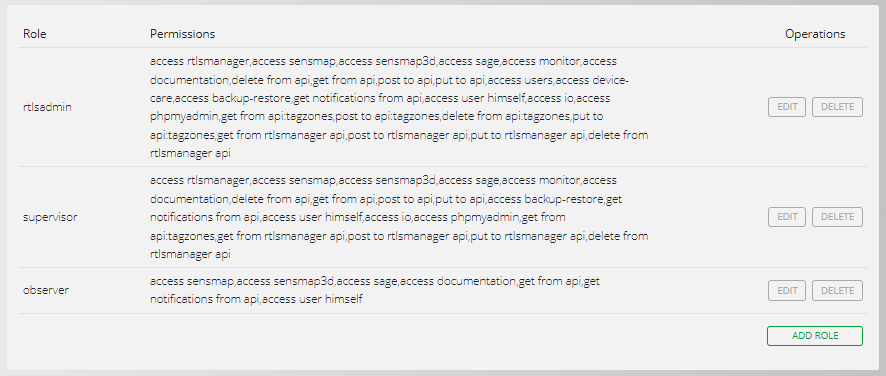Roles
All operations related to managing roles and permissions are made through /roles and /permissions pages. Roles are simply sets of permissions. To give a user only some specific permissions, you have to create a role containing these permissions first.
Please note, that only rtlsadmin and users with appropriate permissions will be able to access this page.
RTLS Studio has got three roles defined in default. In the picture, you can see all the right assigned to individual roles.
- rtlsadmin - a role with access to everything the RTLS Studio has to offer including user management;
- supervisor - a role with access to managing the whole system, except its users;
- observer - a role with access to getting information from RTLS Studio, not being able to make any changes to the system whatsoever;
Also, you can create a new role with certain rights based on your needs. It could be done easily by ADD ROLE button.
Name the new role and specify the role rights. When it is done create the role by ADD button.
Permissions
The table below describes the main permissions.
| Permission | Description |
|---|---|
| access rtlsmanager | access RTLS Manager, control over the devices (tags, anchors) |
access sensmap | access Sensmap, it needs GET FROM API permission as well to be able to use Sensmap |
| access sensmap3d | access Sensmap 3D, it needs GET FROM API permission as well to be able to use Sensmap 3D |
| access sage | access Sage, manage charts, manage tag categories, manage dashboards |
| access backup-restore | access Backup & Restore, empty database, manage backups, manage captures, update RTLS Studio |
| access user himself | edit your profile |
| access users | access Users, manage users, roles and permissions |
| access io | access .IO, manage devices, events and actions |
| access monitor | access RTLS Monitor, start, stop and restart RTLS services, monitor system |
| get from api | obtain information from REST (view tags and anchors in Sensmap, list buildings from API, etc.) |
| post to api | create new items via REST (create new plans, create new zones, etc.) |
| put to api | edit existing items via REST (edit zones, change anchor's position, rename plan, etc.) |
| delete from api | delete items from REST (delete zones, delete buildings, etc.) |

